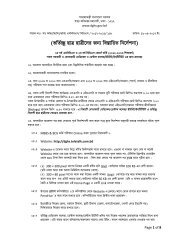Health Bulletin 2009
Health Bulletin 2009
Health Bulletin 2009
Create successful ePaper yourself
Turn your PDF publications into a flip-book with our unique Google optimized e-Paper software.
Safe Blood Transfusion<br />
Though the need for safe blood is unanimous, millions of patients requiring transfusion do<br />
not get opportunity of transfusing safe blood and there is an obvious disproportion between<br />
developing and developed countries in access to safe blood. Of the estimated 80 million<br />
units of<br />
blood donated annually worldwide, less than 45% is collected in developing countries. Acute<br />
haemorrhage due to accident and injuries and during post partum period, maternal and child<br />
anemia resulting from various cause are some of the leading cause of death in the<br />
developing countries. Timely access to safe blood transfusion is a life-saving measure in<br />
many of these clinical conditions and can also prevent serious illness in these patients.<br />
Besides, unsafe transfusion poses serious threat of transmitting infectious diseases that<br />
include HIV/AIDS, hepatitis-B, hepatitis-C, syphilis and malaria.<br />
In our country the annual demand for blood transfusion is estimated to be 3, 00, 000 to<br />
3,50,000 unit per year. But due to lack of voluntary donor and consciousness among people<br />
this demand is hardly met. South East Asia account for 25% of the world's population but<br />
collects only 9% of the world's blood supply as a result 7 million units of blood in a year, but<br />
there is need of a total 15 million units of blood.<br />
Implementation of Safe Blood transfusion started in 2000 with the realization of judicial use<br />
and safety of blood and blood products in Bangladesh in order to ensure collection of blood<br />
not from commercial blood sellers and compulsory screening of blood for 5 blood-borne<br />
diseases viz. HIV/AIDS, hepatitis-B, hepatitis-C, syphilis and malaria before transfusion of<br />
blood. SBTP has 116 safe blood transfusion centers.<br />
A national strategic plan for HIV/AIDS/STD prevention formulated incorporating blood<br />
transfusion sector. Since 2000, screening of Transfusion Transmitted Infection (WHO<br />
recommended) has been introduced in Bangladesh along with judicial act and national<br />
policies ruled by the Government of People's Republic of Bangladesh. Safe blood<br />
transfusion law 2002 has been approved by the parliament and published with an emphasis<br />
towards management and services of safe collection, processing, preservation and<br />
transfusion. The goal was to establish and operation of private blood transfusion centers and<br />
Upazilla blood transfusion centers by 2008. Official Gazette notification of the law has been<br />
published for implementation from 1 st august 2004 and safe blood transfusion ruling order<br />
has been published on 7 th may 2005. Emphasis is given to the outdoor and day care<br />
facilities provided by Transfusion Medicine Department. Safe blood Transfusion Programme<br />
was sponsored by United Nations Development Programme (UNDP) in 2000-2004 and from<br />
2004-onwards is supporting by WORLD BANK, Development for International Development<br />
(DFID), World <strong>Health</strong> Organization(WHO) and <strong>Health</strong>, Nutrition and Population Sector<br />
Programme (HNPSP) .<br />
The National Policy and Strategy on Blood Safety, adopted in 2007, defines minimum<br />
standards and requirements for health facilities to qualify and be authorized to screen blood<br />
for HIV before transfusion. A Reference Laboratory has been set up in Dhaka Medical<br />
College Hospital to conduct HIV confirmatory tests.<br />
"Safe blood transfusion regulations 2008" was published in 17 June 2008. The regulations<br />
say that without taking license from a licensing authority, no person,<br />
organization or institution will be allowed to establish and run a private blood bank.<br />
42


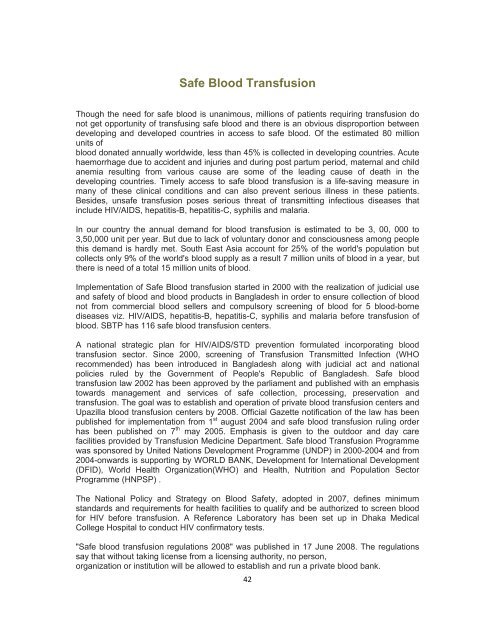
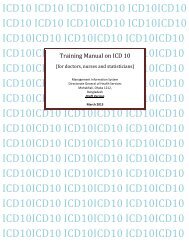




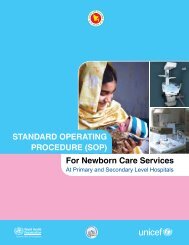
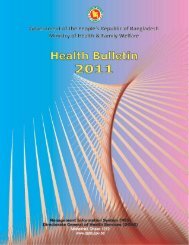
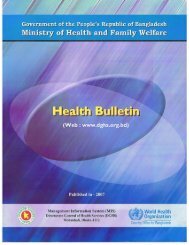
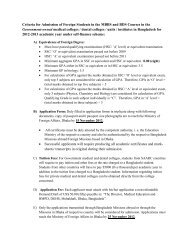
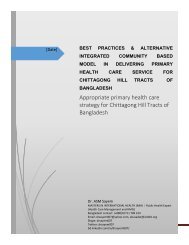
![Bangladesh Demographic and Health Survey 2007 [FR207]](https://img.yumpu.com/38440445/1/190x257/bangladesh-demographic-and-health-survey-2007-fr207.jpg?quality=85)
